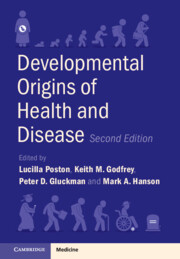Book contents
- Developmental Origins of Health and Disease
- Developmental Origins of Health and Disease
- Copyright page
- Contents
- Contributors
- Preface
- Section I Overview
- Section II Exposures Driving Long-Term DOHaD Effects
- Section III Outcomes
- Section IV Mechanisms
- Section V Interventions
- Chapter 17 Interventions to Prevent DOHaD Effects in Pregnancy
- Chapter 18 Interventions to Prevent DOHaD Effects in Infancy and Early Childhood
- Section VI Public Health and Policy Implications of Interventions
- Index
- References
Chapter 18 - Interventions to Prevent DOHaD Effects in Infancy and Early Childhood
from Section V - Interventions
Published online by Cambridge University Press: 01 December 2022
- Developmental Origins of Health and Disease
- Developmental Origins of Health and Disease
- Copyright page
- Contents
- Contributors
- Preface
- Section I Overview
- Section II Exposures Driving Long-Term DOHaD Effects
- Section III Outcomes
- Section IV Mechanisms
- Section V Interventions
- Chapter 17 Interventions to Prevent DOHaD Effects in Pregnancy
- Chapter 18 Interventions to Prevent DOHaD Effects in Infancy and Early Childhood
- Section VI Public Health and Policy Implications of Interventions
- Index
- References
Summary
This chapter summarizes evidence on the effects of different nutritional interventions or exposures in early childhood on later BMI, overweight/obesity and adiposity. We present findings of a 2016 systematic review of systematic reviews, updated here by a search of Ovid Medline up to May 2020. Sixty-two systematic reviews of observational and/or interventional studies were included. Some early nutritional interventions/exposures might be associated with a later risk of overweight/obesity. No strong and consistent evidence to support a long-term ‘programming effect’ on overweight/obesity was found. Breastfeeding was associated with a modest reduction of later risk of overweight and obesity up to adult life, but residual confounding should be considered. Lowering the protein content of infant formula seems to be a promising intervention to reduce later risk of overweight and obesity in children, although new studies must replicate the effects on long-term health outcomes.
- Type
- Chapter
- Information
- Developmental Origins of Health and Disease , pp. 189 - 202Publisher: Cambridge University PressPrint publication year: 2022



